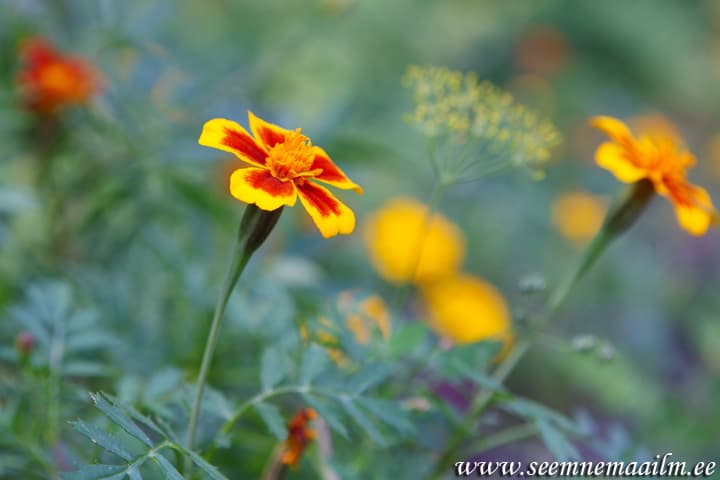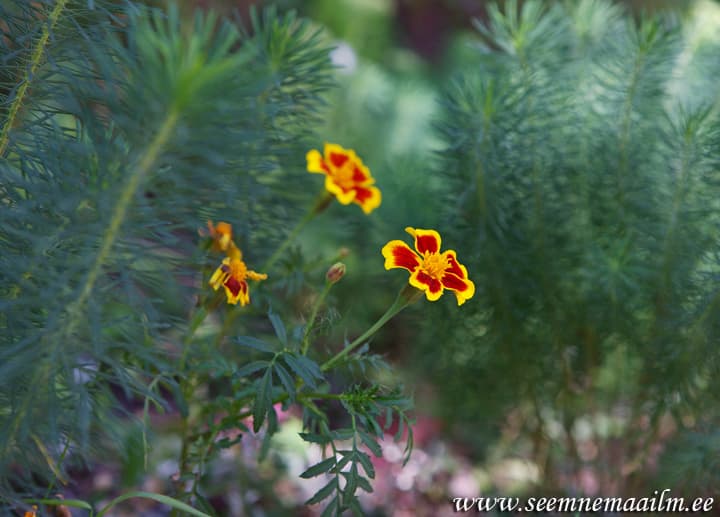Marigolds are unpretentious, fast-growing, light- and heat-loving, drought-resistant plants.
The optimum temperature for the growth of young plants is + 18 + 20 ° C. At temperatures below + 10 ° C, the leaves acquire an anthocyanin bloom and growth stops. Plants die at -1 ..- 2 ° C.

Location: do not need intense sunlight, although they achieve maximum decorativeness in sunny places (especially for marigolds). They do not tolerate spring and autumn frosts.
Soil: Requires nutritious, well-hydrated soil in the first half of summer.
Care: they are considered drought-resistant, but at the beginning of growth they need watering, otherwise the plants will be puny, and the inflorescences will be small. Marigolds, especially erect marigolds, have a negative attitude towards excess moisture in the soil. In rainy weather, their large inflorescences begin to rot. And if the soil is oversaturated with water, plants begin to die from fungal root diseases. Spring fertilization stimulates strong growth but delays the onset of flowering.
Diseases and pests: inflorescences often rot during prolonged rains.
And in dry hot conditions, marigolds are often affected by spider mites. To get rid of plants from it, you must first of all increase the humidity of the air by spraying the seedlings several times a day with water. For complete destruction, use 2-3 times spraying with infusions of onions, hot red pepper, yarrow.
Reproduction: seeds.
In open ground, marigolds can be sown in late May - early June. Seedlings appear 5-10 days after sowing.
It is advisable to cover the soil with a non-woven material. In this case, you can sow a week and a half earlier than usual and thereby accelerate flowering.
To obtain the earliest seedlings, erect marigolds are sown (in mid-March).
Rejected and thin-leaved marigolds are sown in early April. If these deadlines are met, flowering of all three species will begin in June.
It is not difficult to grow marigold seedlings in indoor conditions on a light window, and even better in film greenhouses, where the plants will be the strongest.
To make the seedlings healthy, you need loose, nutritious soil (1 part of humus + 1 part of peat + 1 part of sod land + 0.5 part of sand), an even temperature of + 18 + 22 ° C and moderate watering. Rejected marigolds are less demanding on soil and temperature.
Although the seedlings of marigolds are considered unpretentious, it is better to take fresh soil for sowing, especially for narrow-leaved marigolds, which are more affected by the "black leg" than other species.
Seedlings can be grown in a box, bowl or pot. Drainage (crushed stone, expanded clay, coarse sand) should be poured onto the bottom with a layer of 3 cm or holes should be made. Otherwise, plants may die from fungal diseases. First, 2/3 of the soil is poured onto the drainage, and this layer is compacted by hand or tamping. The next layer should be loose so that the germinating roots have enough air. The soil should not reach the edge of the container by 1-2 cm. The prepared soil is well spilled and left for one or two days in a warm place so that it "breathes".
The seeds of marigolds are large, therefore they can be carefully laid out in the grooves at a distance of 1-1.5 cm. The distance between the grooves themselves is 1.5-2 cm. The thickened seedlings suffer more from a lack of light and stretch out. They may even get black leg disease.
The easiest way to get the optimum density is by sowing germinated seeds. For germination, they need to be laid out on a damp cloth on a saucer and put in a plastic bag, put in a warm place. After 2-3 days, the seeds will hatch. The decomposed seeds are covered with a layer of earth of 0.5-1 cm (poorly covered seeds can die from drying out). If seeds are buried too deep in the soil, they may not grow at all, especially in narrow-leaved marigolds.
After sowing, the top layer of the earth is carefully watered, then covered with paper. The containers are placed in a warm place (+ 22 + 25 ° C) and carefully monitor the soil moisture. After 3-7 days, seedlings will appear and the containers should be transferred to a bright place at a lower temperature (+ 18 + 20 ° С).
If the seedlings are still thickened, they must be dived. For this, the seedlings are carefully removed from the well-watered soil and planted in a hole, deepening to the cotyledons, which will facilitate the formation of new roots.
A good seedling at the time of planting has 2-3 pairs of leaves and a strong root system. Seedlings are planted in the ground in late May and early June. Plants are planted in the soil 1-2 cm deeper than they grew earlier.
The distance between plants depends on the species and variety. Tall hybrids and varieties of erect marigolds are planted according to the scheme 40x40 cm, medium varieties and F1 hybrids 30x30 cm and low varieties and hybrids of all types 20x20 cm.
The transplant is easily tolerated at any age, even in a flowering state.

Signet Marigold, slender-leaf marigold, French marigold single. Bot. syn.: Tagetes patula single.












